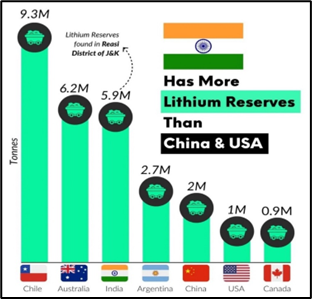Why in News?
- In February 2023, the Geological Survey of India (GSI), for the first time, had established availability of lithium-inferred resources of 5.9 million tonnes in Reasi district of Jammu and Kashmir.
- In a recent finding, this is now likely to extend well beyond the original location where the mineral was detected, and the scope of geological exploration is now being widened.
What’s in today’s article?
- About Lithium (Properties, Applications, Availability, Top Producers, etc.)
- Discovery of Lithium Reserves in India (Location, Quantity)
- News Summary (Lithium extraction process)
About Lithium:
- Lithium is a chemical element with the symbol Li and atomic number 3. It is a soft, silvery-white alkali metal.
- Lithium is a special metal in many ways. It's light and soft — it can be cut with a kitchen knife and so low in density that it floats on water.
Applications of Lithium:
- The most important use of lithium is in rechargeable batteries for mobile phones, laptops, digital cameras and electric vehicles (EVs).
- Lithium is often dubbed as “white gold” for electric vehicles.
- Lithium metal is made into alloys with aluminium and magnesium, improving their strength and making them lighter.
- Aluminium-lithium alloys are used in aircraft, bicycle frames and high-speed trains.
- Lithium has no known biological role. It is toxic, except in very small doses.
Where is Lithium Found Naturally?
- Lithium makes up a mere 0007 per cent of the Earth's crust and it's only found locked up in minerals and salts.
- With 9.3 million tonnes, Chile has the world’s largest known lithium reserves.
- Chile is followed by Australia (6.2 million tonnes), Argentina (2.7 million tonnes) and China (2 million tonnes).
- NOTE – This was before the discovery of 5.9 million tonnes of reserves in J&K.
- Global lithium production surpassed 100,000 tonnes for the first time in 2021, quadrupling from 2010. Currently, Australia alone produces 52% of the world’s lithium.
Future of Lithium Production:
- As the world produces more batteries and EVs, the demand for lithium is projected to reach 1.5 million tonnes of lithium carbonate equivalent (LCE) by 2025 and over 3 million tonnes by 2030.
- Based on the above demand projections, production needs to triple by 2025 and increase nearly six-fold by 2030.
Discovery of Lithium-reserves in India:

- The Geological Survey of India, during preliminary exploration (G3) stage, found that 5.9 million tonnes have been found in Salal-Haimana area of #Reasi district of J&K.
- As part of efforts to augment local reserves of the critical mineral, the GSI has carried out 14 projects on lithium during last five years.
- India now has the third largest resource of lithium globally, but it will take time to convert it to reserves.
News Summary:
- In a recent finding, this is now likely to extend well beyond the original location where the mineral was detected, and the scope of geological exploration for lithium is now being widened.
- Incidentally, lithium was discovered when exploration was underway for two other different minerals – limestone and bauxite.
- When mining commences at the location, there will be three different minerals to be extracted from the catchment zone – bauxite, limestone and lithium.
- Apart from the domestic lithium push, there is also an attempt to tap into established value chains globally.
- A team of experts learnt to have travelled to the Argentinian province of Catamarca recently to scout for opportunities.
- An MoU with the Argentinian government had been signed earlier.
How is Lithium Extracted?
- Lithium is generally produced from two main different deposit types: Brines and Hard-rock.
- Brine –
- Operations exploiting brine deposits pump saline brines with high lithium content from beneath the surface and the lithium is concentrated by way of evaporation.
- Subsequently, the brine is sent on to processing facilities for the production of lithium hydroxide.
- Lithium deposits found in South America are mainly brine deposits.
- In India, there is some potential to recover Lithium from brines of Sambhar and Pachpadra areas, the Rajasthan and Rann of Kutch, Gujarat.
- Hard-rock –
- In case of hard-rock operations of the kind likely in J&K, the ore is extracted, usually from pegmatite deposits, using conventional mining techniques.
- Then, it is concentrated by way of crushing, and separated to produce a concentrate.
- The primary lithium-bearing mineral in this ore is usually spodumene, and the produced spodumene concentrate is then usually sold to lithium hydroxide or carbonate conversion plants.
- At the plants, spodumene is then converted to lithium chemical products.









